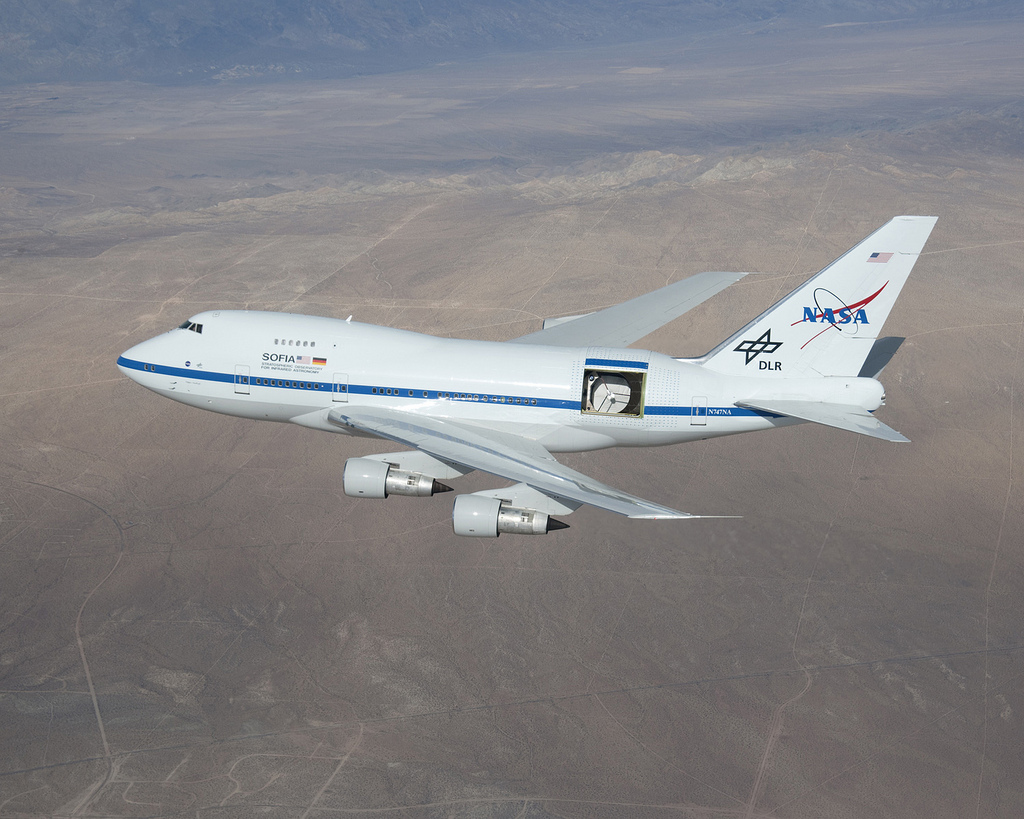The high-flying SOFIA telescope is shedding light on where some of the basic building blocks for life may have originated from. A recent study published on The Astrophysical Journal: Letters led by astronomers from the University of Hawaii, including collaborators from the University of California Davis, Johns-Hopkins University, the North Carolina Museum of Natural Sciences, Appalachian State University, and several international partners (including funding from NASA), looked at a lingering mystery in planet formation: the chemical pathway of the element sulfur, and its implications and role in the formation of planets and life.
Number 16 on the periodic table, sulfur is the tenth most common element in the Universe. Not only is sulfur a tracer element involved in the formation of dust grains around young stars leading to planets, it’s also suspected to be a necessary building block for life. Looking at the distribution of sulfur in the Universe could also give us insight into the story of how primitive life began here on Earth.
For the study, researchers looked at what are known as young stellar objects (YSOs). These are young stars at a stage before they begin fusing hydrogen, and are embedded in a molecular cloud rich in dust and gas. The specific object targeted in the study was MonR2 IRS3, a collapsing protostar in the Monoceros R2 star-forming region. Located in the constellation of Monoceros the Unicorn, (sometimes also known as the Narwhal) MonR2 IRS3 is one of many YSOs in the region, a repository of protoplanetary dust and gas surrounding a collapsing core.

After the YSO stage,the gas has either become part of the star, its planetary system, or is blown away. The star then begins to fuse hydrogen into helium, as well as heavier elements seen in more massive stars. Young stellar objects such as MonR2 IRS3 are thus perfect laboratories for investigating the mysterious chemistry involved in the formation of planets and molecules needed for life.

For the study, the team used SOFIA – NASA’s Stratospheric Observatory For Infrared Astronomy – a converted Boeing 747SP aircraft with a 2.5-meter infrared telescope mounted behind a sliding door and aimed perpendicularly versus the axis of the aircraft. High-flying SOFIA is ideal for such a study, as it can get far above the bulk of the Earth’s atmospheric water vapor, which hinders infrared astronomy.
The team used the high-resolution Echelon-Cross-Echelle Spectrograph (“EXES”) mounted on the SOFIA telescope. Mon2 IRS3 had been observed previously for a study on carbon monoxide (CO) using the NIRSPEC instrument on the large, ground-based Keck II telescope, and these observations helped inform the SOFIA investigation of sulfur dioxide (SO2), a molecule that is thought to be a repository for the sulfur in protoplanetary systems. Sirius, the brightest star in the sky, was also observed to calibrate the data. The EXES observations allowed observers to gauge the spectral line width of SO2 in the star-forming region for the first time, as well as gain insight into the abundance of this molecule as a sulfur reservoir. For example, narrow lines from warm SO2 gas suggests ice sublimation via heat from the forming core, while wide lines are indicative of shocks sputtering sulfur off of small grains. This study found a lower-limit for SO2 abundance, and determined that ices sublimated from the MonR2 IRS3 hot core could be the source of the SO2 gas.

Following the Sulfur
Observations of the sulfur process in a YSO are intriguing. For the first time, the team observed the formation of SO2 (sulfur dioxide) in a hot core, which shows that this mode of formation is at least as efficient as in shocks. Further, this process may be important in lower-mass (i.e., more akin to our solar system when it was forming ~4.57 billion years ago) YSOs, which future observations may help confirm.
Future work may also help establish the relative importance of other primitive sulfur reservoirs. Looking at hydrogen sulfide in YSOs — thought to be the main sulfur contributor in the primitive solar system — shows that simple radiative heating and mild shocks are at least as efficient in the formation and distribution of sulfur, as was previously thought from sputtering, strong shocks. This also shows a strong link between reservoirs of sulfur seen in our own solar system in Comet 67/P Churyumov-Gerasimenko, which was explored by the European Space Agency’s Rosetta mission from 2014 to 2016.
“These observations taken with the SOFIA telescope are key toward unlocking some of the secrets of protoplanetary molecular reservoirs,” Dr. Rachel Smith (North Carolina Museum of Natural Sciences/Appalachian State University) told Universe Today. “Through such connections between different data sets for a single object, we may eventually build a comprehensive picture of the evolution of planets and the molecules needed for life.”
What’s next for new observations? To help confirm the hypothesis for the SO2 reservoir, follow-up observations of sulfur-containing ices are needed from upcoming missions such as the James Webb Space Telescope launching in 2021, and perhaps using the on again, off again WFIRST mission (the Wide Field Infrared Space Telescope) which was zeroed out in the NASA FY 2020 budget proposal.
With the launch of new telescopes and improvements to existing ones, we may be entering the ‘golden age of infrared astronomy’ in the coming decade, allowing astronomers trace elements back to their primordial origins.

